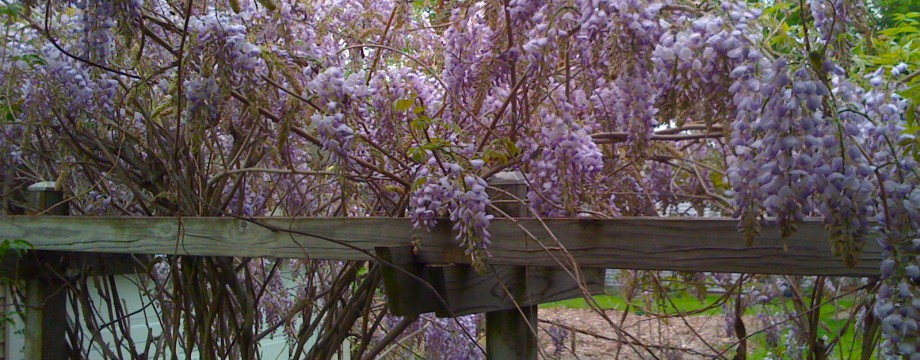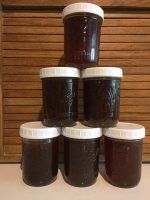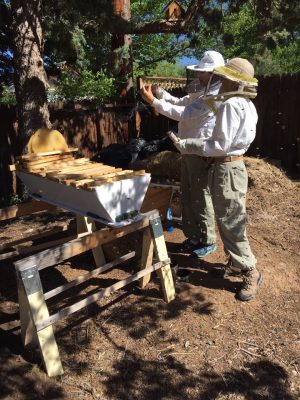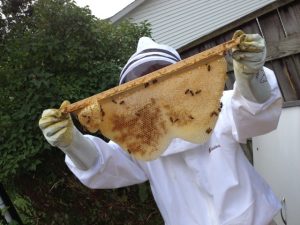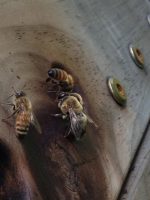Amazing how long a human being can be in a state of hopeful denial.
On Friday, Sept. 13, my bee colony met death and death won.
I debated long and hard whether or not to write this post. So often, in social media, we share highlights and successes. In this blog about city homesteading, I acknowledged that I was not an expert and still have a lot to learn. But did I really want to share about a failure? After writing a post on how I was trying to be a bee guardian and why I thought that a top bar hive was a good way of providing a more natural habitat for bees, did I want to admit that my bees died? Would that mean that I wasn’t a good bee caretaker? Would that cast top bars in a negative light? But, in the end, because both success and failure are learning opportunities, I decided that I would write the story of my bees.
I got my bees at the end of July 2012. They were delivered, along with my hive, from Wisconsin. It was an established small colony with about nine or 10 bars of comb already started. That fall, the bees were busy, gathering and storing honey. I worried about them because I had gotten them so late in the season. Would they be able to store enough honey for the winter? Would there be enough bees so that they could adequately huddle over the winter months and survive the cold?
Winter came and I continued worrying. But bees are used to seasons. I just hoped my colony was strong enough to survive. In late winter, on warm days, I was happy to see bees emerging. When spring came, the bees went off on foraging flights and came back laden with pollen, even though I couldn’t see any flowers blooming yet. I was happy. They were going to make it! I added a few empty bars to the back of the hive to give the colony room to expand and began feeding them some sugar water.
Spring is a tricky time for bees. The weather starts getting warmer and the bees begin leaving the hive to forage for nectar and pollen. But temperatures can fluctuate and a late cold snap might catch bees unprepared. The bees might not be able to cluster together to keep eggs and larvae warm. I watched the activity in and out of the hive anxiously and was relieved when it seemed that the bees were doing what bees are supposed to do.
At the end of June, I started worrying that something was wrong. The bees had started making some new comb in May, but then the work stalled out. Furthermore, it looked like there were significantly fewer bees in the hive. I followed a suggestion to add an empty bar between bars with brood comb (combs that have eggs and larvae) to try to instigate their need to build comb. I was confident that this would work and my bees would continue building up the hive.
A month passed and the bees still hadn’t built any new comb. I was confused. I didn’t know what they were doing. I was seeing many more male drone bees and not as many female worker bees. Furthermore, though there were plenty of flowering plants nearby, the workers were not bringing pollen back to the hive. I started asking some questions on an online forum and was told that I might not have a laying queen bee. Once I had a fertile queen, the workers should start collecting pollen again.
Clearly, it was time to do a more thorough inspection of the hive. I opened up the hive in late July and saw some hopeful signs. It looked like there were some queen cells and, while one of them was closed, a couple of others looked open. Perhaps a queen had hatched. Also, there were more bees inside the hive than I had expected, especially toward the entrance, where an active queen would normally be laying eggs. The bees near the entrance became quite agitated when I was pulling bars off to inspect. I was sure they were protecting a new queen. With renewed hope, I put everything back and covered up the hive.
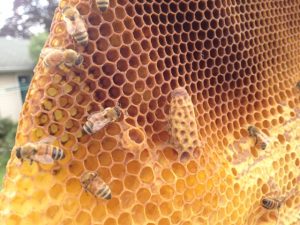 I now had formulated a scenario of what had happened: my bees had swarmed sometime in June, which accounted for the fewer number of bees we were seeing; something had happened to the queen that was left in the hive and the workers had to make another queen – hence the queen cells; a new queen was being made; bees know what they are doing; everything was going to be fine.
I now had formulated a scenario of what had happened: my bees had swarmed sometime in June, which accounted for the fewer number of bees we were seeing; something had happened to the queen that was left in the hive and the workers had to make another queen – hence the queen cells; a new queen was being made; bees know what they are doing; everything was going to be fine.
After a couple of weeks I finally saw some bees bringing back pollen. Even though the population still seemed pretty small, this activity was a very hopeful sign.
Hope turned to dismay at the beginning of September when the population suddenly spiraled downward. I saw hardly any bees outside the hive. Upon opening up the hive for another inspection, I saw dead bees on the floor of the hive, yellow jackets inside probably feasting on honey. There were more bees inside than I had expected to see. That was a good sign. I decided to reduce the size of the hive so that the remaining bees had a smaller territory to defend from the yellow jackets, so I pulled off some of the bars that had comb and honey and closed off two of the entrance holes. I also saw little white worms that I hoped were bee larvae but that I suspected were larvae from pests, either small hive beetle or wax moth.
It was time to bring in an expert. Andy Ammons from Goshen College was going to come on Friday to help me figure out what was going on.
On Friday, I came home from work and saw what I interpreted as a miracle. Bees, many bees, many many bees, all clustering around the entrance of my hive. Hope surged. Even though I knew it wasn’t really the right season for it, I assumed a swarm had found my nearly empty hive and was going to take up residence. Little did I know what really was going on.
Andy clued me in when he arrived. It was not a benevolent swarm. Rather, bees from other colonies, maybe many other colonies, had discovered my weak, failing colony and had come to rob the honey.
The activity of robber bees is amazing to see. It is a frenzy of action as the bees focus on one thing and one thing only – get honey. They pay no attention to anything other than to eat through wax and get to the honey that is stored in the comb. The few remaining guard bees of the original colony stood no chance against the invasion. We saw some fighting, invaders attacking the guard bees and overwhelming them. We saw drone bees, from my colony, begging invaders to feed them honey and invaders oblige. We witnessed the end of my colony, but it was still a pretty impressive sight.
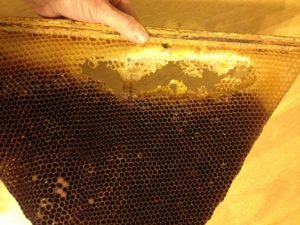 That night, we salvaged what remained of the ravaged comb. There was a tiny bit of honey in some of the cells, but the robbers had been very thorough. Fortunately, for us, we will be able to harvest some honey from the bars we pulled off from our last inspection.
That night, we salvaged what remained of the ravaged comb. There was a tiny bit of honey in some of the cells, but the robbers had been very thorough. Fortunately, for us, we will be able to harvest some honey from the bars we pulled off from our last inspection.
In this tale of the bee colony, I alternated between hope and worry. I clung to all those little signs that seemed to indicate that things were going to be all right. After it was all over for my colony, I posted in our family Facebook group: Amazing how long a human being can be in a state of hopeful denial. My sister in law replied: That spirit has changed history. Not all bad.
There is always next year.
